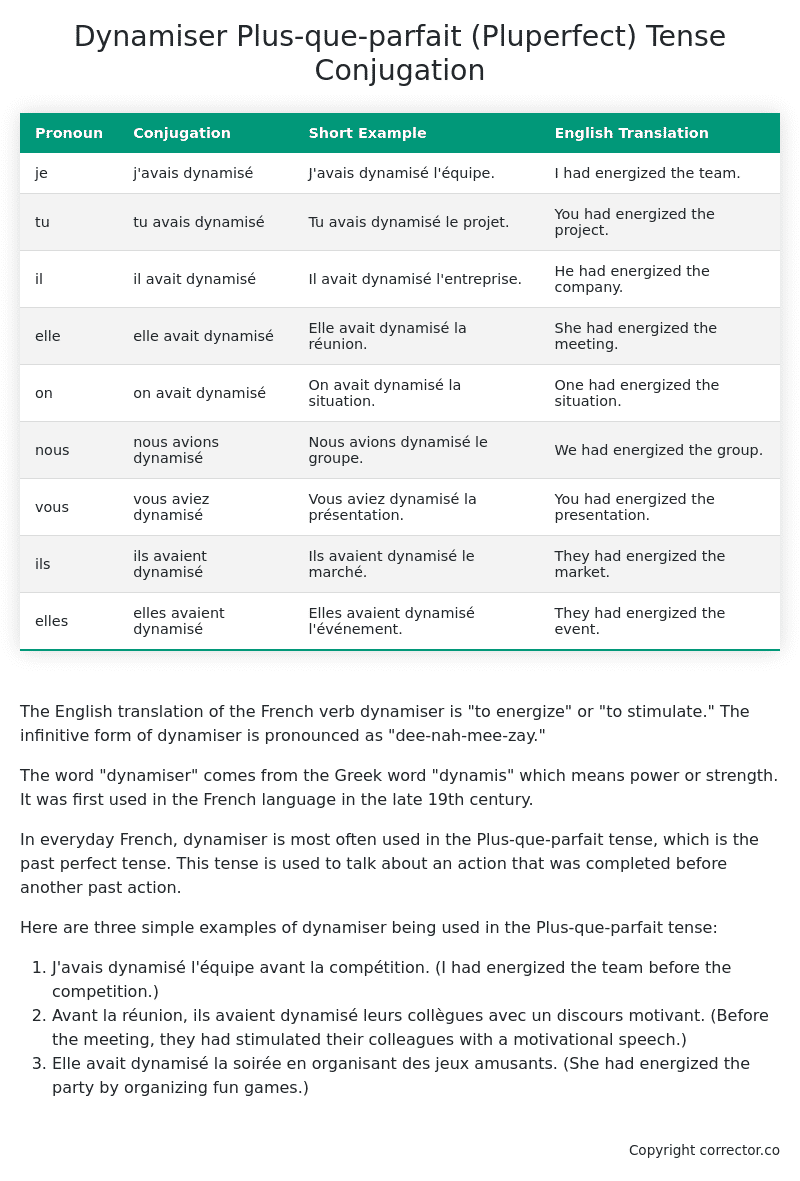Plus-que-parfait (Pluperfect) Tense Conjugation of the French Verb dynamiser
Introduction to the verb dynamiser
The English translation of the French verb dynamiser is “to energize” or “to stimulate.” The infinitive form of dynamiser is pronounced as “dee-nah-mee-zay.”
The word “dynamiser” comes from the Greek word “dynamis” which means power or strength. It was first used in the French language in the late 19th century.
In everyday French, dynamiser is most often used in the Plus-que-parfait tense, which is the past perfect tense. This tense is used to talk about an action that was completed before another past action.
Here are three simple examples of dynamiser being used in the Plus-que-parfait tense:
- J’avais dynamisé l’équipe avant la compétition. (I had energized the team before the competition.)
- Avant la réunion, ils avaient dynamisé leurs collègues avec un discours motivant. (Before the meeting, they had stimulated their colleagues with a motivational speech.)
- Elle avait dynamisé la soirée en organisant des jeux amusants. (She had energized the party by organizing fun games.)
Table of the Plus-que-parfait (Pluperfect) Tense Conjugation of dynamiser
| Pronoun | Conjugation | Short Example | English Translation |
|---|---|---|---|
| je | j’avais dynamisé | J’avais dynamisé l’équipe. | I had energized the team. |
| tu | tu avais dynamisé | Tu avais dynamisé le projet. | You had energized the project. |
| il | il avait dynamisé | Il avait dynamisé l’entreprise. | He had energized the company. |
| elle | elle avait dynamisé | Elle avait dynamisé la réunion. | She had energized the meeting. |
| on | on avait dynamisé | On avait dynamisé la situation. | One had energized the situation. |
| nous | nous avions dynamisé | Nous avions dynamisé le groupe. | We had energized the group. |
| vous | vous aviez dynamisé | Vous aviez dynamisé la présentation. | You had energized the presentation. |
| ils | ils avaient dynamisé | Ils avaient dynamisé le marché. | They had energized the market. |
| elles | elles avaient dynamisé | Elles avaient dynamisé l’événement. | They had energized the event. |
Other Conjugations for Dynamiser.
Le Present (Present Tense) Conjugation of the French Verb dynamiser
Imparfait (Imperfect) Tense Conjugation of the French Verb dynamiser
Passé Simple (Simple Past) Tense Conjugation of the French Verb dynamiser
Passé Composé (Present Perfect) Tense Conjugation of the French Verb dynamiser
Futur Simple (Simple Future) Tense Conjugation of the French Verb dynamiser
Futur Proche (Near Future) Tense Conjugation of the French Verb dynamiser
Plus-que-parfait (Pluperfect) Tense Conjugation of the French Verb dynamiser (this article)
Passé Antérieur (Past Anterior) Tense Conjugation of the French Verb dynamiser
Futur Antérieur (Future Anterior) Tense Conjugation of the French Verb dynamiser
Subjonctif Présent (Subjunctive Present) Tense Conjugation of the French Verb dynamiser
Subjonctif Passé (Subjunctive Past) Tense Conjugation of the French Verb dynamiser
Subjonctif Imparfait (Subjunctive Imperfect) Tense Conjugation of the French Verb dynamiser
Subjonctif Plus-que-parfait (Subjunctive Pluperfect) Tense Conjugation of the French Verb dynamiser
Conditionnel Présent (Conditional Present) Tense Conjugation of the French Verb dynamiser
Conditionnel Passé (Conditional Past) Tense Conjugation of the French Verb dynamiser
L’impératif Présent (Imperative Present) Tense Conjugation of the French Verb dynamiser
L’infinitif Présent (Infinitive Present) Tense Conjugation of the French Verb dynamiser
Struggling with French verbs or the language in general? Why not use our free French Grammar Checker – no registration required!
Get a FREE Download Study Sheet of this Conjugation 🔥
Simply right click the image below, click “save image” and get your free reference for the dynamiser Plus-que-parfait tense conjugation!

Dynamiser – About the French Plus-que-parfait (Pluperfect) Tense
Tense Formation
Common everyday usage patterns
Sequencing of past events
Background information
Hypothetical or reported speech
Interactions with other tenses
Summary
I hope you enjoyed this article on the verb dynamiser. Still in a learning mood? Check out another TOTALLY random French verb conjugation!


